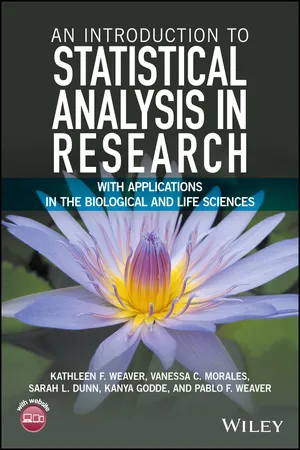
An Introduction to Statistical Analysis in Research
With Applications in the Biological and Life Sciences
- English
- ePUB (mobile friendly)
- Available on iOS & Android
An Introduction to Statistical Analysis in Research
With Applications in the Biological and Life Sciences
About This Book
Provides well-organized coverage of statistical analysis and applications in biology, kinesiology, and physical anthropology with comprehensive insights into the techniques and interpretations of R, SPSS®, Excel®, and Numbers® output
An Introduction to Statistical Analysis in Research: With Applications in the Biological and Life Sciences develops a conceptual foundation in statistical analysis while providing readers with opportunities to practice these skills via research-based data sets in biology, kinesiology, and physical anthropology. Readers are provided with a detailed introduction and orientation to statistical analysis as well as practical examples to ensure a thorough understanding of the concepts and methodology. In addition, the book addresses not just the statistical concepts researchers should be familiar with, but also demonstrates their relevance to real-world research questions and how to perform them using easily available software packages including R, SPSS®, Excel®, and Numbers®. Specific emphasis is on the practical application of statistics in the biological and life sciences, while enhancing reader skills in identifying the research questions and testable hypotheses, determining the appropriate experimental methodology and statistical analyses, processing data, and reporting the research outcomes.
In addition, this book:
• Aims to develop readers' skills including how to report research outcomes, determine the appropriate experimental methodology and statistical analysis, and identify the needed research questions and testable hypotheses
• Includes pedagogical elements throughout that enhance the overall learning experience including case studies and tutorials, all in an effort to gain full comprehension of designing an experiment, considering biases and uncontrolled variables, analyzing data, and applying the appropriate statistical application with valid justification
• Fills the gap between theoretically driven, mathematically heavy texts and introductory, step-by-step type books while preparing readers with the programming skills needed to carry out basic statistical tests, build support figures, and interpret the results
• Provides a companion website that features related R, SPSS, Excel, and Numbers data sets, sample PowerPoint® lecture slides, end of the chapter review questions, software video tutorials that highlight basic statistical concepts, and a student workbook and instructor manual
An Introduction to Statistical Analysis in Research: With Applications in the Biological and Life Sciences is an ideal textbook for upper-undergraduate and graduate-level courses in research methods, biostatistics, statistics, biology, kinesiology, sports science and medicine, health and physical education, medicine, and nutrition. The book is also appropriate as a reference for researchers and professionals in the fields of anthropology, sports research, sports science, and physical education.
KATHLEEN F. WEAVER, PhD, is Associate Dean of Learning, Innovation, and Teaching and Professor in the Department of Biology at the University of La Verne. The author of numerous journal articles, she received her PhD in Ecology and Evolutionary Biology from the University of Colorado.
VANESSA C. MORALES, BS, is Assistant Director of the Academic Success Center at the University of La Verne.
SARAH L. DUNN, PhD, is Associate Professor in the Department of Kinesiology at the University of La Verne and is Director of Research and Sponsored Programs. She has authored numerous journal articles and received her PhD in Health and Exercise Science from the University of New South Wales.
KANYA GODDE, PhD, is Assistant Professor in the Department of Anthropology and is Director/Chair of Institutional Review Board at the University of La Verne. The author of numerous journal articles and a member of the American Statistical Association, she received her PhD in Anthropology from the University of Tennessee.
PABLO F. WEAVER, PhD, is Instructor in the Department of Biology at the University of La Verne. The author of numerous journal articles, he received his PhD in Ecology and Evolutionary Biology from the University of Colorado.
Frequently asked questions
Information
1
Experimental Design
Learning Outcomes
- Define key terms related to sampling and variables.
- Describe the relationship between a population and a sample in making a statistical estimate.
- Determine the independent and dependent variables within a given scenario.
- Formulate a study with an appropriate sampling design that limits bias and error.
1.1 Experimental Design Background
Case Study
1.2 Sampling Design
Random Sample

Systematic Sample

Stratified Sample

Volunteer Sample
Sample of Convenience
- A university researcher interested in studying BMI versus fiber intake might choose to sample from the students or faculty she has direct access to...
Table of contents
- Cover
- Title Page
- Copyright
- Preface
- Acknowledgments
- About the Companion Website
- 1: Experimental Design
- 2: Central Tendency and Distribution
- 3: Showing Your Data
- 4: Parametric versus Nonparametric Tests
- 5: t-Test
- 6: ANOVA
- 7: Mann–Whitney U and Wilcoxon Signed-Rank
- 8: Kruskal–Wallis
- 9: Chi-Square Test
- 10: Pearson's and Spearman's Correlation
- 11: Linear Regression
- 12: Basics in Excel
- 13: Basics in SPSS
- 14: Basics in Numbers
- 15: Basics in R
- 16: Appendix
- Literature Cited
- Glossary
- Index
- EULA